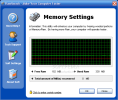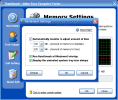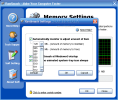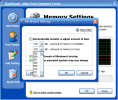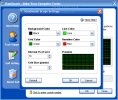RAM is a very important asset for a computer. The more, the merrier. Computers will run faster if you equip them with a powerful processing unit and lots of memory. But few of us know that this "organ" of the computer must also be taken care of, just like the hard disk or the CPU.
Some of you may know that the Operating System (OS) tends to use up to all memory available and leaves the computer running slow. Memory needs to be reallocated to the computer. Some applications that you may not need are also using large quantities of memory which also leads to slowing down your machine.
RamSmash is a little tool that allows the user to gain control on computer memory and continuously frees RAM for you. The software is developed by SwiftDog and the price for its memory recuperating activity is $12.99. The 28 days trial period allows the user to make himself/herself an impression on how the software works and whether it is worth the money or not.
However, the application has a limited functioning time during the trial period. The software will do its job for only one hour, after which, a registering reminder dialog will popup. You will have to force the software to close and then it will begin doing its job for another hour, as if nothing has happened. That is pretty annoying, but you can still evaluate it.
The application is not too demanding, as it needs only a minimum of 90MHz CPU (166MHz recommended), IE 4 or higher, 8MB of RAM (32MB of RAM recommended) and 5MB of space on your hard disk.
The program has three windows where you can meddle. The main application window will display the vertically arranged menus on the left and the current state of your computer memory. The only worthy of analysis menu is the Soft Settings one, which will allow you to set the amount of memory to maintain and the amount of memory to be freed.
In here, the user can set the software to run at Windows startup so that you will always have it functioning, even if you forget about it. Another option in Settings is to display the animated version of its icon in the system tray.
The third window of the application is somehow hidden, because there is no button to signal its existence, and if I hadn't been intrigued by the fact that I found two windows and the Help file displayed three, I wouldn't have found it.
Clicking the memory status window is the secret entrance to the Scope Settings dialog box. Here, the user can configure the colors of the memory status window. These settings are extremely useful for the color-blinded. Thus, you can change the default colors for the line, baseline, the background or the grid so that they best visually transmit the current state of the memory of your computer.
You can also set the frequency of recording the status of the computer memory (the rate of the line and baseline moving rate) in terms of percentage of a second. The rate can be set between 1% and 100% of a second. In addition to that, the user can change the grid of the diagram and make it larger or smaller (set the number of pixels per square).
The little preview window in the right side will display the changes you made and if you are pleased with them, press the OK button. If you think that the default values were more appropriate, all you have to do is hit the Default button and all settings in this window will return to the original settings.
The Default button is available in the Settings window, too. So, if you want to return to the initial amount of RAM monitored and adjusted by the software you can do it at any time you want.
The default value for the RAM the program will maintain is 128MB and for the memory to free is of 230MB. These values are not fixed and the user can go up to 512MB for each of them.
The Good
Such a software is sometimes a necessity for less experienced computer users. And having a well reallocated computer memory will result in your machine performing better.
The software is easy to use and once you have made the desired settings, you can send it to the system tray and forget about it.
The Bad
Although I only saw it once, that register reminding window becomes a real nag in the course of one day. Finding that Scope Settings window was not difficult, but it would have been nice to have a button or to be specified in the Help menu how it can be accessed.
The Truth
It is nice to see the results of the application in a chart. The memory used by the application is of about 5MB.
Here are some snapshots of the application in action:
 14 DAY TRIAL //
14 DAY TRIAL // 